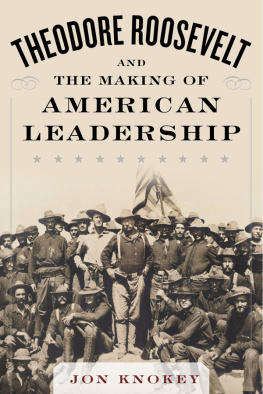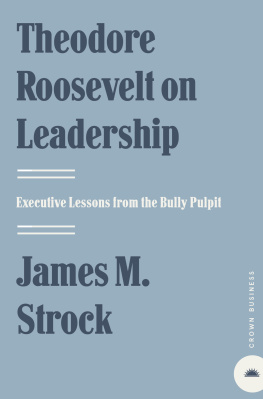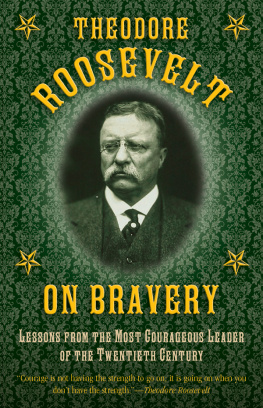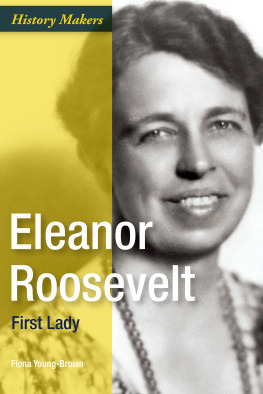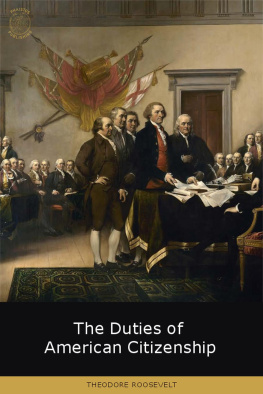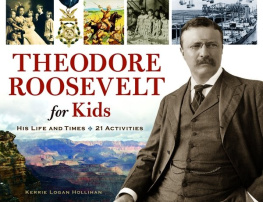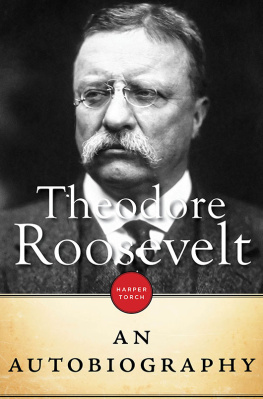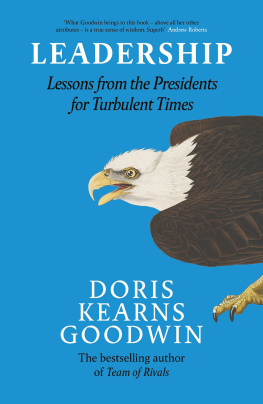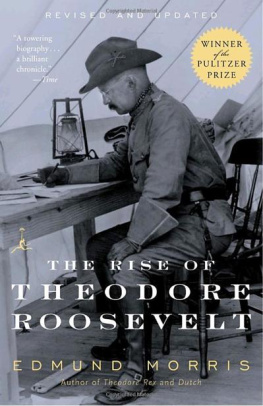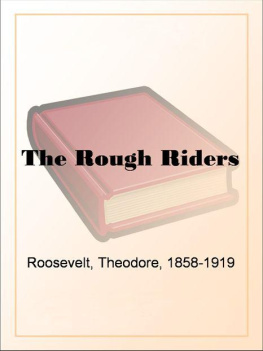Copyright 2015 by Jon A. Knokey
All rights reserved. No part of this book may be reproduced in any manner without the express written consent of the publisher, except in the case of brief excerpts in critical reviews or articles. All inquiries should be addressed to Skyhorse Publishing, 307 West 36th Street, 11th Floor, New York, NY 10018.
Skyhorse Publishing books may be purchased in bulk at special discounts for sales promotion, corporate gifts, fund-raising, or educational purposes.
Special editions can also be created to specifications. For details, contact the Special Sales Department, Skyhorse Publishing, 307 West 36th Street, 11th Floor, New York, NY 10018 or .
Skyhorse and Skyhorse Publishing are registered trademarks of Skyhorse Publishing, Inc., a Delaware corporation.
Visit our website at www.skyhorsepublishing.com.
10 9 8 7 6 5 4 3 2 1
Library of Congress Cataloging-in-Publication Data is available on file.
Cover design by Tom Lau
Cover image courtesy of the Theodore Roosevelt Collection, Houghton Library, Harvard University
Print ISBN: 978-1-63450-356-3
Ebook ISBN: 978-1-5107-0130-4
Printed in the United States of America
For Meghan
My wife, my dearest friend
If I have anything at all resembling genius, it is in the gift for leadership... To tell the truth, I like to believe that, by what I have accomplished without great gifts, I may be a source of encouragement to Americans.
Theodore Roosevelt
Contents
Preface

Union Square, New York City. April 25th, 1865
At two oclock in the afternoon, the casket was loaded onto a wagon pulled by sixteen horses. The box was six feet six inches in length and lined with lead. A small plate had been bolted to the outside:
ABRAHAM LINCOLN, SIXTEENTH PRESIDENT OF THE UNITED STATES, BORN FEB, 12 1809, DIED APRIL 15, 1865
Eleven days had passed since John Wilkes Booth fired a bullet from a .44 caliber Derringer and further devastated a nation already divided by civil war. The joy from the recent armistice between Ulysses S. Grant and Robert E. Lee had been obliterated by murder. Just days after the most terrible of wars had ended, America had now lost her president in a final crescendo of senseless violence.
The funeral processionretracing the route that had brought president-elect Lincoln into a house already dividedtreaded solemnly through the streets of New York City. It was the citys turn to mourn and ask the Almighty for strength. It was their time to honor the man who gave the last full measure of devotion so that their nation might live. It was fitting and proper that thousands of citizens lined the streets. A light rain drizzled, church bells rang, Americans wept openly.
The clouds above were heavy and deep. Lampposts and homes were draped in large black shrouds. Black horses, cloaked in black cloth, pulled the black canopied hearse past mourners dressed in dark frock coats and holding black umbrellas. Behind the casket limped the Invalid Brigade, a column of wounded and deformed soldiers.
In the mass of people, homemade signs and banners were visible: GODS NOBLEST WORK, AN HONEST MAN, OUR CHIEF HAS FALLEN. The poet Walt Whitman, tortured by the event, would turn to poetry to grieve:
O Captain! my Captain! rise up and hear the bells;
Rise upfor you the flag is flungfor you the bugle trills;
For you bouquets and ribboned wreathsfor you the shores a-crowding;
For you they call, the swaying mass, their eager faces turning;
Here Captain! dear father!
This arm beneath your head;
It is some dream that on the deck,
Youve fallen cold and dead.
As Abraham Lincolns cortege made its way into Union Square, a photographer captured an iconic scene. Two young boyssix-year-old Theodore and his younger brother, Elliottpeer out of the second story window of the mansion owned by their grandfather, Cornelius Van Schaack Roosevelt. Alongside the boys had been little Edith Carow. Not quite four years old, she began to cry at the sight of the disfigured men below. Annoyed, young Theodore shoved his future wife into a back room and locked the door. She never saw the service.
The procession rolled into Union Square where a rabbi, an archbishop and a minister all looked heavenward for answersperhaps reading the same Bible, perhaps praying to the same God. When prayers were finished, the funeral march continued west to Fifth Avenue before turning north to 34th Street. The procession took one last turn west towards the Hudson River Railway Depot at the corner of 30th Street and 10th Avenue.
At the Railway Depot, a guard of honor placed the coffin back aboard the Lincoln Special, a locomotive with the martyred presidents photograph above the cowcatcher. At 4:15 p.m., the train slowly broke from the station. Its next stop was Albany. After that, Buffalo, Cleveland, Columbus, Indianapolis, Michigan City, Chicago. The 1,654-mile route would eventually take Mr. Lincoln home to Springfield, Illinois. In the larger cities, a magazine wrote, the casket would be unloaded and paraded through the streets; in the countryside farmers standing beside their bonfires in the dark and rain would catch only a glimpse of the train as it passed.
As the locomotive charged west, southern cities still smoldered from Shermans march to the sea. America was shattered, still divided. The country was left to bind up her wounds. All its citizens pondered whether the better angels of its nature would ever again swell the full chorus of the Union.

Thirty-three years later, San Juan Heights, Santiago de Cuba. July 1st, 1898
At about 11:00 a.m. the Spanish bullets began to fall like the first drops of a rainstorm. Soldiers trampled over the dead, desperate to find cover.
The men could not retreat and they could not remain. There was only one option: charge the guns fortified on top of the hill.
Theodore Roosevelt jumped on his horse and rode to the front. One trooper remembers a great distinction. He didnt say Go on; he said, Come on!
The patriotic outburst inspired the nearby 9th Cavalrythe African-American Regiment-known throughout America as the Buffalo Soldiers. They sprinted to join the charge.
The united men at the bottom of San Juan Heights now represented all of America: Aristocrats from the east, cowboys from the west, millionaires, paupers, shyster lawyers, quack doctors, farmers, college professors, miners, adventurers, preachers, prospectors, socialists, journalists, clerks, Mormons, musicians, publicists, Jews, politicians, Gentiles, Mexicans, professed Christians, Indians, West Point graduates, wild men, Ivy League athletes, and thinkers. They were from the North and they were from the South. They were from every part of the Union. They had one leader, Theodore Roosevelt.
Roosevelt was the only man on horseback, an easier target for his men to follow as well for the enemy, who were trained to aim at officers. He was dressed in khaki trousers, a blue flannel shirt, and a brown felt hat; he had tied a blue polka-dot bandana to his head, described as both a warriors headdressand a bulls eye.
By God, there go our boys up the hill! someone yelled from the military attach a mile and a half away. They can never take it, another moaned. Never in the world. It is slaughter, absolute slaughter, another cried in horror.
Amidst a shower of enemy bullets, Roosevelt galloped ahead.

